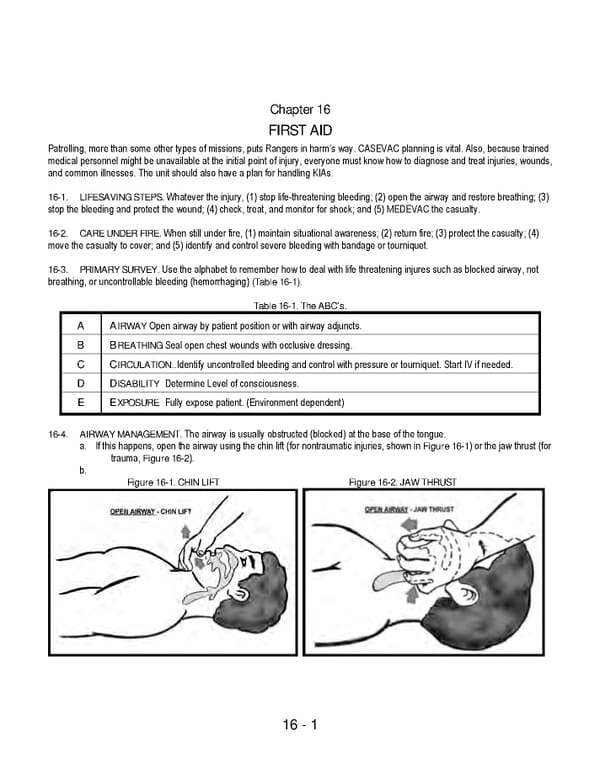16 - 1 Chapter 16 FIRST AID Patrolling, more than some other types of missions, puts Rangers in harm’s way. CASEVAC planning is vital. Also, because trained medical personnel might be unavailable at the initial point of injury, everyone must know how to diagnose and treat injuries, wounds, and common illnesses. The unit should also have a plan for handling KIAs. 16-1. LIFESAVING STEPS. Whatever the injury, (1) stop life-threatening bleeding; (2) open the airway and restore breathing; (3) stop the bleeding and protect the wound; (4) check, treat, and monitor for shock; and (5) MEDEVAC the casualty. 16-2. CARE UNDER FIRE. When still under fire, (1) maintain situational awareness; (2) return fire; (3) protect the casualty; (4) move the casualty to cover; and (5) identify and control severe bleeding with bandage or tourniquet. 16-3. PRIMARY SURVEY. Use the alphabet to remember how to deal with life threatening injures such as blocked airway, not breathing, or uncontrollable bleeding (hemorrhaging) (Table 16-1). Table 16-1. The ABC’s. A AIRWAY Open airway by patient position or with airway adjuncts. B BREATHING Seal open chest wounds with occlusive dressing. C CIRCULATION .. Identify uncontrolled bleeding and control with pressure or tourniquet. Start IV if needed. D DISABILITY Determine Level of consciousness. E EXPOSURE Fully expose patient. (Environment dependent) 16-4. AIRWAY MANAGEMENT. The airway is usually obstructed (blocked) at the base of the tongue. a. If this happens, open the airway using the chin lift (for nontraumatic injuries, shown in Figure 16-1) or the jaw thrust (for trauma, Figure 16-2). b. Figure 16-1. CHIN LIFT Figure 16-2. JAW THRUST
 Ranger Handbook Page 296 Page 298
Ranger Handbook Page 296 Page 298